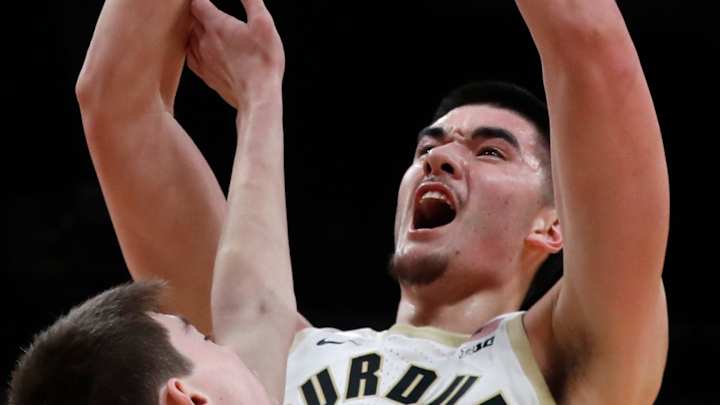Carving Out A Role for Zach Edey: Introduction

In this story:
More than in any other team sport, basketball welcomes individuality in players’ games. Given the nuance and fragmentation of NBA schemes, they are easily tweaked to optimize valuable skills.
Many of the world’s best players have brought unique skill sets to the sport and molded new ways to play the game. Stephen Curry’s revolutionary shooting ability combined with Draymond Green’s genius provided the foundation for Golden State’s dynastic read-and-react offense. Nikola Jokic’s one-of-a-kind passing ability vaulted him to status as the league’s first true “point center”.
Even when unorthodox players don’t alter the entirety of the sport with their arrival, they can carve out paths to stardom by being exceedingly effective with their peculiar approach. Jalen Brunson has become one of the best point guards in the league by torching defenses inside the arc with guile, footwork, and touch.
On a smaller scale, this principle remains true for role players. By adding more minor wrinkles to the proper squads, they can make use of their eccentric archetypes and create a path to impact.
For example, take Brandon Clarke. Despite being an undersized big, he uses his stellar touch and athleticism to function as a valuable play-finisher for Memphis by seeping into gaps on offense. Additionally, he adds rebounding and some versatile defense. For Minnesota, Kyle Anderson has found a role as a jumbo-sized, self-paced, initiator regardless of his lack of quickness. His size, craft, and passing chops get the job done and he too brings defense.
Other prominent names that fit this bill include Aaron Gordon, Larry Nance Jr, Gary Payton II, Jarred Vanderbilt, Precious Achiuwa, and Bruce Brown.
On the contrary, the successes mentioned earlier come alongside an abundance of failed cases. There have been many prospects whose games were too out-of-style for their own good - they couldn’t excel in any sort of typical role and weren’t able to uncover a niche in which their redeeming skills could shine.
So, how does one go about projecting whether a unique player can bring value in the league? In a field already defined by uncertainty, the additional theorizing makes this a difficult question. I believe the answer varies on a case-by-case basis, and they each need to be approached in a different way.
Enter: Zach Edey
Zach Edey has dominated the world of college basketball this season. On his way to becoming the runaway National Player of the Year, the 7-foot-4 big man has ran Purdue’s top-tier offense by way of the interior. Over 65% of his shot attempts come out of the post, and practically all of them are finishes at the basket. To be the national player of the year with this shot diet, you have to be exceptional at them, which the Canadian very much is. Per Synergy Sports, Edey ranks in the 83rd percentile in efficiency out of post-ups, 90th percentile in rim attempts, and 79th percentile on hook shots en route to his 22.6 PPG on 63.8 TS%. Additionally, he wreaks havoc on the glass, tallying 5.5 offensive rebounds per contest.
However, in the past, a plethora of college bigs have destroyed defenses with dominance down low. Nearly all of these players have struggled to find a consistent role in the NBA. In a more perimeter-oriented time, there hasn’t been much room for this archetype. Luka Garza, Iowa’s NPOY in 2021, is the most recent instance.
But with his frame and skill set, the 7-foot-4, 305-lb boilermaker puts a unique twist on this archetype and forces us to take a deeper look at his legitimacy as a prospect.
Will Edey have a similar outcome to the majority of other NCAA low-post phenoms, or do his differences open up more tangible paths to value at the next level?
We can begin to formulate a response to this larger question by investigating some more targeted ones:
- How well will Edey be able to score on NBA bigs on the block?
- How well will Edey be able to pass out of the post effectively?
- How well will Edey be able to score within the flow of the offense?
- How good will Edey be defensively?
It’s definitely important to phrase these questions with a futuristic outlook. Despite how absurdly dominant he is right now, he is still just 20 years old. He can, and will, continue to develop as a pro.
Diving into these four questions isn’t something I can tackle in this piece alone. The response to each of these requires comprehensive analysis, which I will bring in the near future through multiple individual pieces.
Want to join the discussion? Like Draft Digest on Facebook and follow us on Twitter to stay up to date on all the latest NBA Draft news. You can also meet the team behind the coverage.

Arya is an NBA & NBA Draft analyst from Boston, Massachusetts. He has produced content on specific players and teams as well as general basketball philosophy.
Follow achawlz